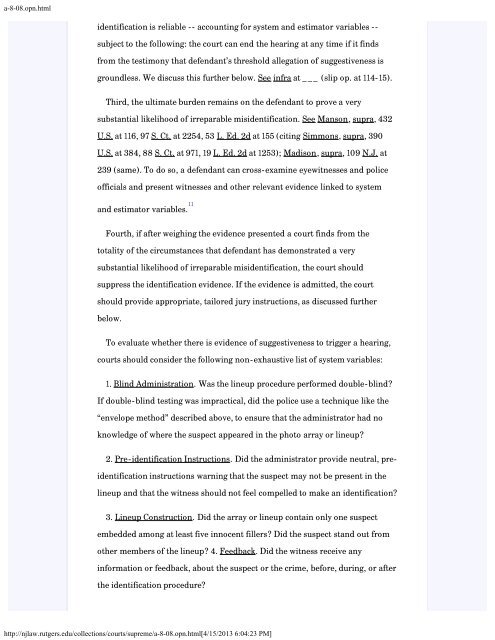State v. Henderson and the New Model Jury Charges - New Jersey ...
State v. Henderson and the New Model Jury Charges - New Jersey ...
State v. Henderson and the New Model Jury Charges - New Jersey ...
Create successful ePaper yourself
Turn your PDF publications into a flip-book with our unique Google optimized e-Paper software.
a-8-08.opn.html<br />
identification is reliable -- accounting for system <strong>and</strong> estimator variables --<br />
subject to <strong>the</strong> following: <strong>the</strong> court can end <strong>the</strong> hearing at any time if it finds<br />
from <strong>the</strong> testimony that defendant’s threshold allegation of suggestiveness is<br />
groundless. We discuss this fur<strong>the</strong>r below. See infra at ___ (slip op. at 114-15).<br />
Third, <strong>the</strong> ultimate burden remains on <strong>the</strong> defendant to prove a very<br />
substantial likelihood of irreparable misidentification. See Manson, supra, 432<br />
U.S. at 116, 97 S. Ct. at 2254, 53 L. Ed. 2d at 155 (citing Simmons, supra, 390<br />
U.S. at 384, 88 S. Ct. at 971, 19 L. Ed. 2d at 1253); Madison, supra, 109 N.J. at<br />
239 (same). To do so, a defendant can cross-examine eyewitnesses <strong>and</strong> police<br />
officials <strong>and</strong> present witnesses <strong>and</strong> o<strong>the</strong>r relevant evidence linked to system<br />
<strong>and</strong> estimator variables. 11<br />
Fourth, if after weighing <strong>the</strong> evidence presented a court finds from <strong>the</strong><br />
totality of <strong>the</strong> circumstances that defendant has demonstrated a very<br />
substantial likelihood of irreparable misidentification, <strong>the</strong> court should<br />
suppress <strong>the</strong> identification evidence. If <strong>the</strong> evidence is admitted, <strong>the</strong> court<br />
should provide appropriate, tailored jury instructions, as discussed fur<strong>the</strong>r<br />
below.<br />
To evaluate whe<strong>the</strong>r <strong>the</strong>re is evidence of suggestiveness to trigger a hearing,<br />
courts should consider <strong>the</strong> following non-exhaustive list of system variables:<br />
1. Blind Administration. Was <strong>the</strong> lineup procedure performed double-blind?<br />
If double-blind testing was impractical, did <strong>the</strong> police use a technique like <strong>the</strong><br />
“envelope method” described above, to ensure that <strong>the</strong> administrator had no<br />
knowledge of where <strong>the</strong> suspect appeared in <strong>the</strong> photo array or lineup?<br />
2. Pre-identification Instructions. Did <strong>the</strong> administrator provide neutral, preidentification<br />
instructions warning that <strong>the</strong> suspect may not be present in <strong>the</strong><br />
lineup <strong>and</strong> that <strong>the</strong> witness should not feel compelled to make an identification?<br />
3. Lineup Construction. Did <strong>the</strong> array or lineup contain only one suspect<br />
embedded among at least five innocent fillers? Did <strong>the</strong> suspect st<strong>and</strong> out from<br />
o<strong>the</strong>r members of <strong>the</strong> lineup? 4. Feedback. Did <strong>the</strong> witness receive any<br />
information or feedback, about <strong>the</strong> suspect or <strong>the</strong> crime, before, during, or after<br />
<strong>the</strong> identification procedure?<br />
http://njlaw.rutgers.edu/collections/courts/supreme/a-8-08.opn.html[4/15/2013 6:04:23 PM]
















